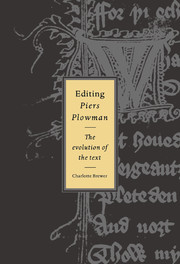Book contents
- Frontmatter
- Contents
- Acknowledgements
- Abbreviations
- Note on the texts
- Introduction
- Part I The early phase
- Part II The late nineteenth century
- Part III The Skeat aftermath
- Part IV Chambers and Grattan, Knott and Fowler
- Part V The Athlone Press edition
- Part VI Epilogue: the Athlone aftermath: Schmidt, Pearsall, Rigg-Brewer, et al.
- Works cited
- General index
- Index of manuscripts
- CAMBRIDGE STUDIES IN MEDIEVAL LITERATURE
Introduction
Published online by Cambridge University Press: 20 August 2009
- Frontmatter
- Contents
- Acknowledgements
- Abbreviations
- Note on the texts
- Introduction
- Part I The early phase
- Part II The late nineteenth century
- Part III The Skeat aftermath
- Part IV Chambers and Grattan, Knott and Fowler
- Part V The Athlone Press edition
- Part VI Epilogue: the Athlone aftermath: Schmidt, Pearsall, Rigg-Brewer, et al.
- Works cited
- General index
- Index of manuscripts
- CAMBRIDGE STUDIES IN MEDIEVAL LITERATURE
Summary
This book is about the editing of Piers Plowman. The poem survives in over fifty manuscripts, all of which differ from each other to a greater or lesser extent. Most of them fall, very roughly, into three main narrative shapes, which have traditionally been called A, B, and C. Others can be squeezed into these three categories only with great difficulty. It is generally supposed that the various versions stem ultimately from a single author, William Langland, who wrote and then revised his poem several times towards the end of the fourteenth century.
The job of the editor is a tricky one. He or she must scrutinise and analyse the scribally preserved evidence of Langland's words and produce for the modern reader something that approximates to a satisfactory reproduction of them. Even this brief description begs many questions. Should the editor aim to penetrate the veil of scribal corruption (for all scribes introduce errors into their texts as they transcribe them), and by some means or other divine exactly what the author originally wrote? Or should he or she be content to produce something approximating to what Langland's contemporary audience would have read? To what extent do the differences between the manuscripts reflect authorial revision, and to what extent scribal corruption? Is it possible that the author produced more than the three traditionally identified versions of his poem, either wholesale rewritings or interim revisions? Or are the rogue manuscripts of the poem (to explain which the last suggestion has been invoked) attributable instead to extensive scribal rewriting of the work, for purposes it is now impossible to reconstruct?
- Type
- Chapter
- Information
- Editing Piers PlowmanThe Evolution of the Text, pp. 1 - 4Publisher: Cambridge University PressPrint publication year: 1996
- 1
- Cited by

